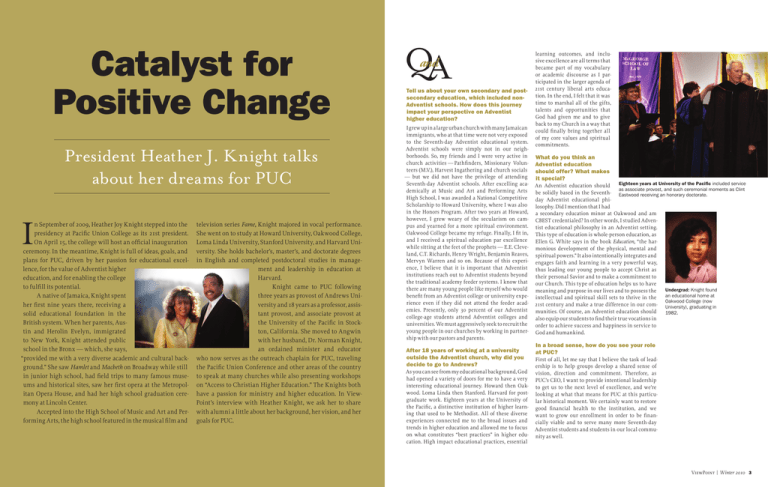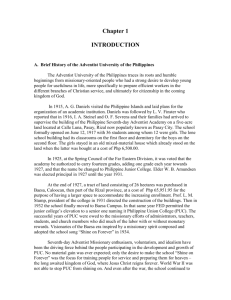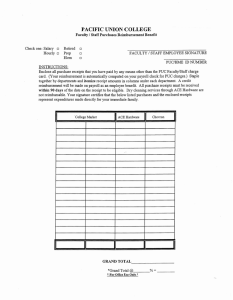Catalyst for Positive Change
advertisement

Catalyst for Positive Change President Heather J. Knight talks about her dreams for PUC I n September of 2009, Heather Joy Knight stepped into the presidency at Pacific Union College as its 21st president. On April 15, the college will host an official inauguration ceremony. In the meantime, Knight is full of ideas, goals, and plans for PUC, driven by her passion for educational excellence, for the value of Adventist higher education, and for enabling the college to fulfill its potential. A native of Jamaica, Knight spent her first nine years there, receiving a solid educational foundation in the British system. When her parents, Austin and Herolin Evelyn, immigrated to New York, Knight attended public school in the Bronx — which, she says, “provided me with a very diverse academic and cultural background.” She saw Hamlet and Macbeth on Broadway while still in junior high school, had field trips to many famous museums and historical sites, saw her first opera at the Metropolitan Opera House, and had her high school graduation ceremony at Lincoln Center. Accepted into the High School of Music and Art and Performing Arts, the high school featured in the musical film and television series Fame, Knight majored in vocal performance. She went on to study at Howard University, Oakwood College, Loma Linda University, Stanford University, and Harvard University. She holds bachelor’s, master’s, and doctorate degrees in English and completed postdoctoral studies in management and leadership in education at Harvard. Knight came to PUC following three years as provost of Andrews University and 18 years as a professor, assistant provost, and associate provost at the University of the Pacific in Stockton, California. She moved to Angwin with her husband, Dr. Norman Knight, an ordained minister and educator who now serves as the outreach chaplain for PUC, traveling the Pacific Union Conference and other areas of the country to speak at many churches while also presenting workshops on “Access to Christian Higher Education.” The Knights both have a passion for ministry and higher education. In ViewPoint’s interview with Heather Knight, we ask her to share with alumni a little about her background, her vision, and her goals for PUC. QA and Tell us about your own secondary and postsecondary education, which included nonAdventist schools. How does this journey impact your perspective on Adventist higher education? I grew up in a large urban church with many Jamaican immigrants, who at that time were not very exposed to the Seventh-day Adventist educational system. Adventist schools were simply not in our neighborhoods. So, my friends and I were very active in church activities — Pathfinders, Missionary Volunteers (M.V.), Harvest Ingathering and church socials — but we did not have the privilege of attending Seventh-day Adventist schools. After excelling academically at Music and Art and Performing Arts High School, I was awarded a National Competitive Scholarship to Howard University, where I was also in the Honors Program. After two years at Howard, however, I grew weary of the secularism on campus and yearned for a more spiritual environment. Oakwood College became my refuge. Finally, I fit in, and I received a spiritual education par excellence while sitting at the feet of the prophets — E.E. Cleveland, C.T. Richards, Henry Wright, Benjamin Reaves, Mervyn Warren and so on. Because of this experience, I believe that it is important that Adventist institutions reach out to Adventist students beyond the traditional academy feeder systems. I know that there are many young people like myself who would benefit from an Adventist college or university experience even if they did not attend the feeder academies. Presently, only 30 percent of our Adventist college-age students attend Adventist colleges and universities. We must aggressively seek to recruit the young people in our churches by working in partnership with our pastors and parents. After 18 years of working at a university outside the Adventist church, why did you decide to go to Andrews? As you can see from my educational background, God had opened a variety of doors for me to have a very interesting educational journey. Howard then Oakwood. Loma Linda then Stanford. Harvard for postgraduate work. Eighteen years at the University of the Pacific, a distinctive institution of higher learning that used to be Methodist. All of these diverse experiences connected me to the broad issues and trends in higher education and allowed me to focus on what constitutes “best practices” in higher education. High impact educational practices, essential learning outcomes, and inclusive excellence are all terms that became part of my vocabulary or academic discourse as I participated in the larger agenda of 21st century liberal arts education. In the end, I felt that it was time to marshal all of the gifts, talents and opportunities that God had given me and to give back to my Church in a way that could finally bring together all of my core values and spiritual commitments. What do you think an Adventist education should offer? What makes it special? Eighteen years at University of the Pacific included service An Adventist education should as associate provost, and such ceremonial moments as Clint be solidly based in the Seventh- Eastwood receiving an honorary doctorate. day Adventist educational philosophy. Did I mention that I had a secondary education minor at Oakwood and am CBEST credentialed? In other words, I studied Adventist educational philosophy in an Adventist setting. This type of education is whole-person education, as Ellen G. White says in the book Education, “the harmonious development of the physical, mental and spiritual powers.” It also intentionally integrates and engages faith and learning in a very powerful way, thus leading our young people to accept Christ as their personal Savior and to make a commitment to our Church. This type of education helps us to have Undergrad: Knight found meaning and purpose in our lives and to possess the an educational home at intellectual and spiritual skill sets to thrive in the Oakwood College (now 21st century and make a true difference in our com- University), graduating in munities. Of course, an Adventist education should 1982. also equip our students to find their true vocations in order to achieve success and happiness in service to God and humankind. In a broad sense, how do you see your role at PUC? First of all, let me say that I believe the task of leadership is to help groups develop a shared sense of vision, direction and commitment. Therefore, as PUC’s CEO, I want to provide intentional leadership to get us to the next level of excellence, and we’re looking at what that means for PUC at this particular historical moment. We certainly want to restore good financial health to the institution, and we want to grow our enrollment in order to be financially viable and to serve many more Seventh-day Adventist students and students in our local community as well. ViewPoint | Winter 2010 3 We also want to keep on being a first-rate institution academically. Having had our Western Association of Schools and Colleges (WASC) accreditation visit in October, which was focused on our capacity and infrastructure to function as a viable institution of higher learning that fulfills our mission, WASC will next focus on our educational effectiveness. We will need to keep developing a culture of evidence, a focus on student learning outcomes and the accomplishments of our graduates. Of course, PUC has many, many outstanding graduates, so that should not be a problem. Additionally, a president has to set a compelling academic and spiritual vision for her institution and inspire and empower others to do their best work and to achieve their hopes and dreams. I also want to focus on institutional sustainability by recruiting the best and the brightest faculty and staff to teach and mentor our students, both academically and spiritually. I believe that we must also be a light to higher education at large, which, by the way, is now experiencing a religious renaissance of sorts. We can help show the way. We must be elite without being elitist. So I really see my role as being a catalyst for positive change. What are some goals for your first year here? The first one is to restore financial stability to the college. I also want to connect with our “I love interacting with people,” says multiple constituents — our alums of course, Knight. The Family Gathering, held just before individuals in the regions that we serve, the school started, gave her a chance to meet different conferences, our conference and and converse with many faculty and staff union leadership. I want to get out and about members. and get a sense of what people need from PUC and whether or not we are meeting their needs. We want to be a viable choice for our Adventist families in the region, so we need to know what they want and to deliver the product that they want for their young people. Furthermore, I am interested in exploring how PUC can provide intellectual, cultural and spiritual capital to our region. If PUC disappeared today, would our community miss us? I hope so. I am already working on developing several partnerships with other community organizations as we work to enhance town/gown relationships. I also want to have a really vibrant, relevant, memorable, engaging learning environment, so that every classroom that students walk into on our campus will be tranformative. I want to challenge faculty members who are already doing a wonderful job to keep thinking about continuous improvement of The ringing of the Healsdburg Bell at Opening Convocation was Knight’s their courses. Our students now, the Millenials, are first contribution to PUC traditions. really in a whole different modality than we were. They’re using technology in a very seamless and natural way. Are we really engaging them in the modality in which they learn best? We want to provide a 4 ViewPoint | Winter 2010 powerful context for learning here, and empower our faculty and students with the tools they need to have powerful and transformative learning experiences. My other first-year goals include beginning Strategic Planning, enhancing internal and external public relations, as well as supporting PUC’s goals to enhance and celebrate our wonderful ethnic and international diversity. One of your mantras is “from good to great.” Tell us about this philosophy and how it applies to your leadership style. Jim Collins, the author of Good to Great, was a professor at Stanford Business School, so I knew about his research on the factors and business practices that helped companies make the leap from being just good companies to becoming great companies. In fact, Collins often said, “good is the enemy of great.” This often becomes true as institutions become complacent and settle for the status quo and forget about innovation and excellence. For me, the good to great framework is a theoretical framework for institutional improvement and excellence. I have always believed that God calls us to true excellence and empowers us to be able to achieve high levels of performance. As the Lexus mantra says, “the relentless pursuit of perfection.” My leadership style, I hope, inspires and empowers others to envision and to enact higher and higher levels of performance as we work collectively to improve organizational culture and performance. You are a self-professed lover of the arts. What role do the arts play in a student’s intellectual and spiritual development? My premise is that God is the ultimate Creative Force in the universe. He has given us as human beings creative faculties as well, which we express in a variety of artistic venues. By engaging the arts, we understand more fully the beauty and complexity of the human condition. The arts also offer us opportunities for emotional and spiritual catharsis through the joys of music, art, literature and so forth. In the end, students can experience God’s creative power through an engagement with the arts. What does it feel like to be the first female president, and the first Black president, of PUC? God has provided me with this marvelous opportunity to be a bit of a pacesetter and pioneer. It is, therefore, a tremendous honor to be able to use all of the gifts and experiences that He has enabled me to have in service to PUC as the College’s first female and first Black president. In many ways, this position is a culminating experience for me, and I am deeply grateful. Many individuals, of many different backgrounds and hues, have served as my mentors and colleagues over the years and are also responsible for my present success. Of course, I have to also thank my parents, husband and children for their support over the years as I have worked hard to balance familial and career goals. What do you think is PUC’s biggest asset as an educational institution? How do you see your relationship with alumni? Its reputation as a Christian liberal arts college that delivers an ivy-league quality education through the medium of committed Christian professors and staff. We have students who go on to medical and dental school at a very high rate and also to very prestigious graduate schools and workplaces. PUC, though, is also very much a destination campus nestled in the spectacular mountains of Napa Valley, so our location provides both nature and nurture. I have already attended a number of alumni events, and there are many others planned. My advancement vice president Pam Sadler and I will be out and about up and down the state, seeing alums in Southern, Central and Northern California, as well as other areas in our constituency. By early next year we will be heading to the East as well, to Tennessee and to Andrews, my former institution. So we’ll be visiting with alums, visiting with donors, thanking them for their gifts, and seeing how they may want to continue helping PUC as we move forward to become a great institution. I love interacting with people, and so I want to be able to connect with our alumni, find out who they are, their concerns, their joys, and get a sense of how they feel about PUC and how to maintain those critical connections with them. In the first months of your presidency, have you picked up on any quirks or cherished traditions at PUC? The campus really has a “green ethos” in that there is such an emphasis on nature activities like mountain bike riding, hiking and the like. The campus community is also very committed to recycling and other ways of trying to sustain the environment. I have also started a new tradition, the ringing of the Healdsburg Bell at our Opening Convocation program, which takes place at the beginning of each new school year. Many alumni have followed the process of and debate over the Angwin Ecovillage proposal. How do you approaching this hot topic? lage project, while also being willing to listen to other points of view. It is fair to say that my approach is to try to find common ground even among opposing points of view. Sometimes there is tension between higher education and the church, especially when it comes to ideas that conflict with our faith. How do we deal with these as a Christian institution of higher learning? I always start with the realization that God is the Author of all true knowledge, and He is an Infinite God. Therefore, as a Christian intellectual, I am committed to critical inquiry and “thinking about my thinking” but always with the knowledge that I “see through a glass darkly.” There are moments in my spiritual and intellectual journey when I may have to live with some ambiguity as God continues to reveal Himself to me through the lens of faith. This attempt to integrate faith and learning is an exciting lifelong project. My dissertation project at Stanford, for example, was an attempt to integrate religion and literature, and I am still passionate about the integration of faith and learning in my work as a Christian admin- Knight celebrates the arts at PUC with Margrit Mondavi at Piano Fantasia (see page 16). istrator. You stepped into the presidency at a difficult time in higher education, and PUC has its own challenges. How do these impact your approach to leading PUC? John Gardner, founder of Common Cause and author of the classic leadership text On Leadership, was the speaker at my 1991 commencement at Stanford University. Gardner described himself as “a toughminded optimist,” and I have always loved that phrase. For leadership, optimism and moderation are best. I am not someone who believes that the past was better than the present or the future. God has placed me in this historical moment to play a crucial role on His world stage right now. Therefore, I embrace this moment, and I believe that He has empowered me for the work that He has called me to do. I also believe that if we pool our collective wisdom and energies together, we can be creative problem solvers who create new solutions that do not presently exist. Therefore, I am very optimistic about the future of Pacific Union College, and I believe that our best days are ahead! This is a hot topic indeed. In my two months on campus so far, I have been learning more about the Ecovil- ViewPoint | Winter 2010 5

